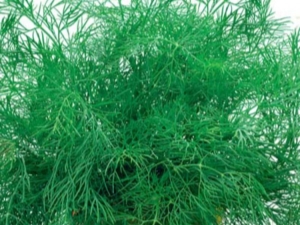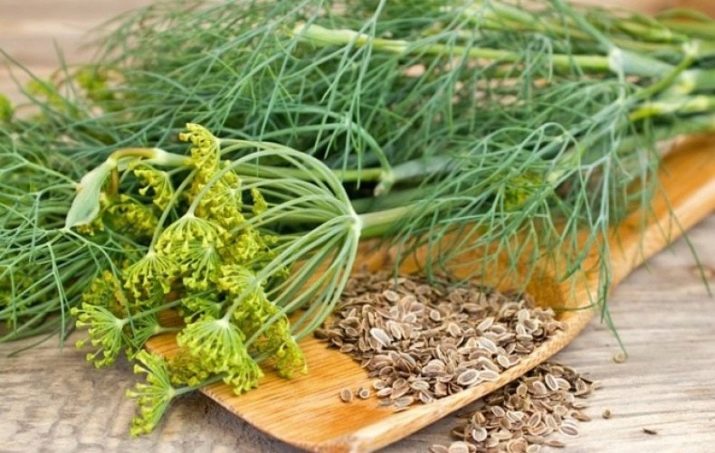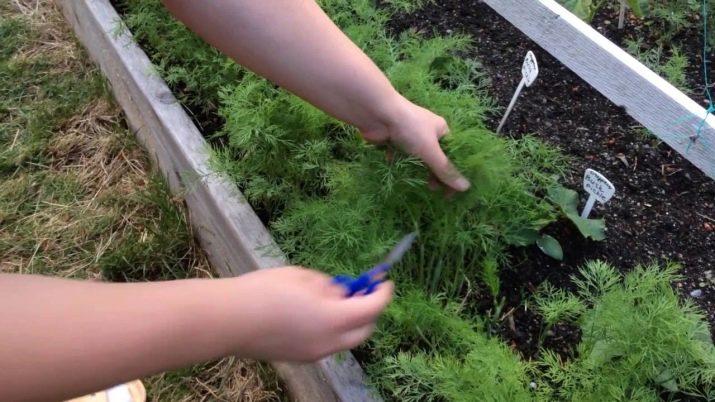Varieties of dill: a variety of varieties, characteristics and differences

Dill is a popular spicy herb.The properties and characteristics of this culture make it possible to use it not only for the preparation of a large number of culinary dishes. It is used in folk medicine and cosmetology. Therefore, this spicy culture can be found on almost all personal plots in different climatic regions, as well as in greenhouses and on the windowsills of multi-storey buildings.
The wide popularity of dill has pushed breeders to develop new varieties of spices that have improved properties and taste. On the shelves of grocery stores and supermarkets you can find a large amount of greenery of this type, and specialized outlets offer their customers a wide selection of high-quality seed material of different varieties. Before buying, you must carefully study the properties of the product and its characteristics. Only the correctly chosen planting material and competent care for it will allow you to collect high-quality crops in the required quantity.
general characteristics
Dill is an odorous annual plant used to prepare not only culinary dishes, but also medical preparations. Culture is not a multi-year, universal. Not only dark green leaves are used, but also stems, seeds and roots.
The most favorable climate for growing this crop is warm, humid and sunny, and the best soil is fertile and loose.
With a lack of moisture in the plant wither and turn yellow leaves. The culture reacts positively to additional watering, the application of mineral and organic fertilizers. Creating comfortable conditions for the growth and development of spices will have a positive effect on the quantity and quality of the harvested crop.
Dill is recognized as a useful plant. Its healing properties have a positive effect on the digestive system and nervous system, normalize blood pressure and heal the body.
Professional breeders brought a large number of varieties of this crop, which have different properties, description and functionality. Before sowing the selected variety of dill, it is necessary to determine the purpose of its cultivation. There are several options for the appointment of spicy culture:
- getting green mass;
- cooking marinades;
- seed collection.
On the shelves of specialized stores there are several types of spices:
- early;
- average;
- late
Early varieties are grown for spring harvest of greens. Medium imply a collection of greenery and young inflorescences for conservation. The later ones are intended for growing green mass without re-seeding during the summer period. Cultivation of several types of dill on the household plot with different ripening terms will provide an opportunity to harvest from early spring to the last month of autumn.
Early
Getting the early green dill to create spring festive salads - the main task of many gardeners. The planting of early ripe varieties can be carried out not only in early spring, but also in late autumn. Dignity can be called an early harvest. The disadvantages are the rapid appearance of inflorescences and a small amount of green mass. The most popular representatives of this type of spice are several varieties.
- "Grenadier" - universal bushy species of dill, the collection of greens which can be carried out 30 days after sowing throughout the growing season.
- "Gribovsky" - the most common form for regions with a temperate climate. You can grow a plant not only in the open field, but also in greenhouses and greenhouses. This variety has powerful bright green leaves with a height of more than 20 cm and a rich aroma. The variety has a high percentage of yield. Culture is not only unpretentious, but also has a high resistance to various types of diseases.
- "Further" - high-yielding variety, used to obtain a large amount of greenery, not only on private plots of land, but also on specialized fields.Greens are used for drying, freezing, preservation, as well as for mass sales in retail chains. A distinctive feature - a characteristic bloom on the leaves.
- "Umbrella" - a very early variety, the planting of seeds of which can be carried out after the snow has disappeared. Getting the first harvest occurs in early May. Harvesting the last harvest is carried out 80 days after sowing.
- "Redoubt" - a compact plant, the collection of which is carried out greens 40 days after sowing. The culture has high taste and rich aroma.
- "Vologda laces" - precocious species of dill bush grown for early harvest. This type has a universal purpose and a high percentage of yield.
Mid-season
The average group of plants forms up to ten powerful leaves in one node, growing in order. This allows you to extend the collection of fresh crop. The best representatives of the mid-season and deciduous category of dill are several varieties.
- Umbrella - a powerful hybrid with a stem height of up to two meters. The leaves are green and large, the diameter of the inflorescence can reach 15 cm. There can be more than 30 flowers in one umbrella. One bush can give up to 20 g of green mass.
- Amazon - productive leafy type of spice. The number of sheets on one plant is more than 15 pieces, the total commodity weight is up to 40 g. The peculiarity of the variety is the raised shape of the rosette, which prevents the ingress of dirt on the leaves during watering or rain.
- Kibray - a popular variety in regions with low temperatures and frequent frosts. Harvesting takes place 60 days after seeding. The height of the leaves reaches 45 cm. With one square meter you can get more than 4 kg of yield.
Sowing can be done in late autumn, but be sure to cover the early green with a special material.
- "Max" - unpretentious and compact plant. Sowing of seeds is carried out in the period of warming up the soil to 10 degrees or more. The first shoots can be seen after 10 days. One square meter of crops gives 3 kg of crop. Harvested herbs have a pleasant aroma and delicate flavor.
- "Richelieu" - a powerful plant up to 130 cm high. The variety has high not only culinary, but also decorative indicators. The leaves are very beautiful, "fishnet." Seeds can be planted from early spring to late autumn.
- "Russian size" - an annual plant with a powerful rosette and a spreading bush. The culture is used for fresh consumption, has pronounced aromatic properties. The height of the stem reaches one meter.
- "Hercules" - high-yield species used for mass cultivation for sale. Unpretentiousness and disease resistance allow you to collect a high percentage of green mass. This variety is far superior in size and yield to other varieties of dill.
- "Lesnogorodsky" - medium early variety with delicate and fragrant greens. The advantages include the preservation of the presentation of green for a long period of time.
Late
For winter harvesting experienced gardeners recommend planting late varieties of dill. These species have a number of undeniable advantages:
- long period of harvest;
- high percentage of vitamins;
- late formation of umbrellas;
- juicy greens.
Representatives of this type are three popular varieties.
- "Alligator" - the most demanded variety planted for greenery. The height of the leaves is more than 30 cm. This type is resistant to the formation of inflorescences, harvesting can be done several times. When creating favorable conditions, more than 100 g of fragrant greens can be collected from one bush.
- "Frost" - very tall plant. This type is the most popular for drying and freezing. With long-term storage, it retains its properties and spicy smell.
- "Ataman" - A universal plant that gives a lot of greenery. This species has a wide range of applications and is a very popular variety.
What to choose for landing?
The selection of the right variety for planting is a crucial step in influencing the harvest. Positive reviews have the best varieties of dill, listed in the State Register. It should be borne in mind that each variety has its own individual qualities that must be considered when planting spicy crops.
To get aromatic herbs with a high content of essential oils, you should pay attention to such varieties as "Alligator", "Frost", "Amazon", "Kutuzovsky", "Grenadier", "Redut". They will delight with high-quality greenery throughout the summer period and will retain their aroma as much as possible not only fresh, but also after drying or freezing.
Many gardeners are trying to choose those varieties of dill, which matures the minimum number of umbrellas. When the inflorescences appear, the greens become coarse, hard and non-aromatic, which negatively affects its taste. Breeders have not yet brought varieties that do not form peduncles. Therefore, experienced gardeners recommend choosing those varieties of culture that have late maturation of the inflorescences. The most prominent representatives of this group are Ozornik, Alligator, Hoarfrost, and Dill.
For cultivation on the windowsill, it is better to give preference to such high-yielding varieties as "Grenadier", "Richelieu" and "Kibray". Any of these species will allow you to collect a good harvest of greenery, even at home.
How to collect?
Compliance with the rules when collecting greens will help preserve the flavor and properties of a useful culture. Harvesting green mass should be carried out 35 days after the appearance of the first shoots, when the plant height reaches more than 20 cm. Experienced gardeners recommend using special tools - garden shears or pruner shears to collect the fragrant and healthy dill greenery.
Before cutting the dill, it must be poured abundantly with water. Work should be carried out carefully, trying not to damage the root system of the plant.
If it is wrong to cut off the spice and damage the roots, then you can not get the next harvest of green mass. Cut the stems at a distance of about 2 cm from the ground.
Collected plants should be rinsed under cold water and dried in a ventilated and protected from sunlight. They can not only be consumed fresh, but also dried, frozen, used for making blanks for the winter.
Review dill varieties in the following video.
































